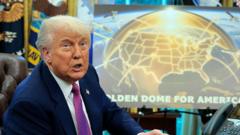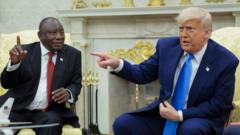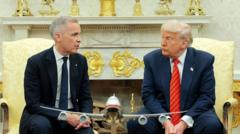As Donald Trump pushes for the creation of the "Golden Dome," experts weigh the feasibility and implications of this high-cost project amid evolving global threats.
**Trump's Ambitious 'Golden Dome' Defense Plan: A New Era in U.S. Security?**

**Trump's Ambitious 'Golden Dome' Defense Plan: A New Era in U.S. Security?**
Is the U.S. ready for the ambitious missile defense system proposed by Trump?
In a bold stride toward enhancing national security, U.S. President Donald Trump has unveiled plans for an innovative defense initiative called the "Golden Dome." Aimed at countering advanced missile threats, including those posed by Russia and China, this conceptual defense system seeks to transcend traditional capabilities primarily designed to intercept intercontinental ballistic missiles (ICBMs).
Experts have raised alarms over current U.S. missile defense systems, which some argue are outdated and vulnerable to new types of warfare. The potential for catastrophic electromagnetic pulses (EMP) from high-altitude nuclear detonations could plunge the nation into chaos, disrupting essential services and technology. In light of these chilling possibilities, the Golden Dome aims not only to address the immediate need for improved missile interception but also to revolutionize U.S. defense strategies against a new generation of threats.
While initial estimates suggest a cost of $175 billion—covering an initial $25 billion investment—some analysts argue the price could soar past $542 billion over two decades. Given the complexities inherent in developing layered defense capabilities that can engage threats from land, sea, and space, there is skepticism regarding Trump's ambitions. The current U.S. Missile Defense Agency relies on limited ground-based interceptors already overwhelmed by the arsenals of major adversaries.
Similar to Israel’s Iron Dome, which focuses on shorter-range threats, the Golden Dome aims to provide a comprehensive framework capable of detecting and neutralizing a range of missile threats, including hypersonic weapons and fractional orbital bombardment systems. However, crafting such a multifaceted system will require not only significant funding but also advanced technology that currently does not exist.
There are concerns that an arms race could ensue as global rivals respond to the heightened U.S. capabilities. Chinese officials have already raised alarm about the plan's potential to escalate tensions, suggesting that it may prompt adversaries to devise countermeasures. Nevertheless, proponents of the Golden Dome maintain that bolstering U.S. defenses will strengthen deterrence against aggression.
Ultimately, as the Trump administration pursues this ambitious campaign, experts urge caution. The path towards establishing the Golden Dome may be fraught with challenges, but its implementation could redefine the landscape of modern warfare and security for the nation.
Experts have raised alarms over current U.S. missile defense systems, which some argue are outdated and vulnerable to new types of warfare. The potential for catastrophic electromagnetic pulses (EMP) from high-altitude nuclear detonations could plunge the nation into chaos, disrupting essential services and technology. In light of these chilling possibilities, the Golden Dome aims not only to address the immediate need for improved missile interception but also to revolutionize U.S. defense strategies against a new generation of threats.
While initial estimates suggest a cost of $175 billion—covering an initial $25 billion investment—some analysts argue the price could soar past $542 billion over two decades. Given the complexities inherent in developing layered defense capabilities that can engage threats from land, sea, and space, there is skepticism regarding Trump's ambitions. The current U.S. Missile Defense Agency relies on limited ground-based interceptors already overwhelmed by the arsenals of major adversaries.
Similar to Israel’s Iron Dome, which focuses on shorter-range threats, the Golden Dome aims to provide a comprehensive framework capable of detecting and neutralizing a range of missile threats, including hypersonic weapons and fractional orbital bombardment systems. However, crafting such a multifaceted system will require not only significant funding but also advanced technology that currently does not exist.
There are concerns that an arms race could ensue as global rivals respond to the heightened U.S. capabilities. Chinese officials have already raised alarm about the plan's potential to escalate tensions, suggesting that it may prompt adversaries to devise countermeasures. Nevertheless, proponents of the Golden Dome maintain that bolstering U.S. defenses will strengthen deterrence against aggression.
Ultimately, as the Trump administration pursues this ambitious campaign, experts urge caution. The path towards establishing the Golden Dome may be fraught with challenges, but its implementation could redefine the landscape of modern warfare and security for the nation.




















